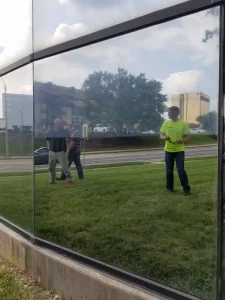Quick Links:
- What is hard water and how does it cause damage?
- How do calcium and mineral deposits build up on glass surfaces?
- What can you do about hard water damage to exterior glass?
- Do I need professional glass restoration to fix hard water stains?
- Special considerations for cleaning architectural glass surfaces
Architectural glass lends a sleek, modern aesthetic to commercial buildings and creates a welcoming storefront for retail patrons. It enhances the view from inside of a building and contributes to energy efficiency and security.
However, windows and other exterior glass components are highly vulnerable to damage from harsh weather, pollutants and normal wear and tear. Hard water is one common problem that can leave unsightly discoloration, streaks and etching.
Removing hard water staining is essential for restoring a clean, professional appearance. However, improper cleaning methods can exacerbate the problem, and stains become more difficult to remove the longer they remain untreated.
Professional glass restoration that includes hard water stain removal is recommended for existing stains. In addition, treatments that protect against future damage help to ensure a longer service life and easier cleaning.
What is hard water and how does it cause damage?

Water hardness refers to the amount of dissolved minerals, such as calcium or magnesium, that are present in water. It is measured in milligrams per liter:
- Soft water = 0-60 mg/L
- Moderately hard water = 61-120 mg/L
- Hard water = 121-180 mg/L
- Very hard water = More than 180 mg/L
Water hardness varies throughout the United States. According to the U.S. Geological Survey, soft water is more common in the Southeast, while hard water tends to be higher in the Midwest and Southwest.
How do Calcium and Mineral deposits Build Up on Glass Surfaces?
We experience the effects of hard water in many different ways. For example, it leaves calcium deposits in water heaters, which shortens the life of the equipment. Calcium also builds up inside of pipes, hampering water pressure for a reduced flow.
Hard water also damages exterior glass and other architectural assets. As moisture evaporates, calcium and other minerals are left behind. This causes unattractive stains, degrading aesthetic quality and giving the building a dirty, run-down appearance. Hard water stains give glass a cloudy appearance which detracts from the view when looking out of windows from inside the building.
Hard water damage often comes from minerals leaching onto the glass from concrete walls. It may also be caused by soap scum left behind from improper cleaning or overspray from sprinkler systems.
When left untreated these stains become etched into the glass. The worst case scenario is stage 3 etching, which may require machine polishing to remove.
What can you do about hard water damage to exterior glass?
Prompt removal of hard water damage is highly recommended for long-lasting results, as permanent damage can occur if it is left untreated. Regular, proper cleaning helps to ward off additional staining.
A professional glass refinisher will consider the types of glass present. Many different varieties of architectural glass can be found on storefronts and other commercial building applications:
- Clear or transparent glass
- Tinted or coated glass
- Frosted glass
- Safety glass including tempered, security, laminated and wired glass
- Insulated glass including dual pane, gas-filled and treated glass
Do I need professional glass restoration to fix hard water stains?
Other factors that will determine appropriate cleaning products and methods for hard water stains include:
- The nature of the stain, such as whether it has penetrated the surface.
- How long the stain has been present.
- Whether the stain has been exposed to long periods of ultraviolet sunlight.
Glass restoration goals include removal of minerals from the surface, along with oils, soap scum and grime buildup. For mild hard water staining that hasn’t penetrated the surface, a gentle cleaner applied with a towel or sponge is usually sufficient. Once the stains have become etched into the pores of the glass, a determination can be made as to the stage of etching and the required process for removal.
Special considerations for cleaning architectural glass surfaces
Different varieties of architectural glass coatings are common in different regions, and are selected based on local weather patterns. Coated glass surfaces, such as Low-E glass, require specially tailored cleaning. Specialized sponges, pads and cleaning solutions should be used, and aggressive scrubbing should be avoided.
At Mid America Specialty Services, our glass refinishers have the training and experience to remove hard water stains and other forms of damage. We provide customized service to clean and protect many different types of exterior architectural glass.
If you’d like to learn more about restoring and maintaining the value of your architectural assets, contact us online or call 800-544-4576.
